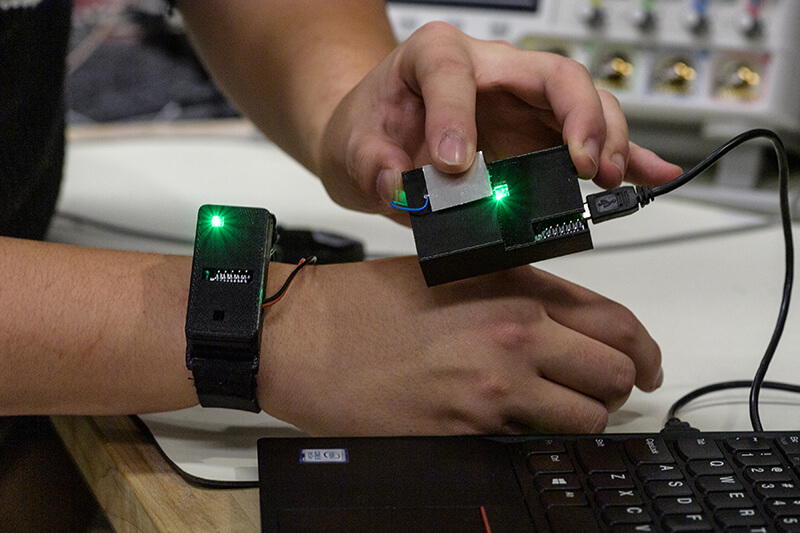2020/12/3 アメリカ合衆国・パデュー大学

・ パデュー大学が、指先で直接触れるだけで様々な情報を送信する、電気準静的(quasi-static)領域を活用した「BodyWire-HCI」技術のプロトタイプを開発。
・ 腕に装着したプロトタイプトランスミッターからの信号を、ワイヤのような通信チャネルとして身体を利用して周囲のデバイスに送信し、人間とコンピューター間のインタラクションを可能にする。
・ クレジットカードやスマートフォンの情報を、身体を介してリーダーやスキャナーに送信する。同プロトタイプでは送金はまだ不可能だが、指先による接触のみで情報を送信する初の技術となる。
・ スマートフォン、ペースメーカーやインスリンポンプ等のウェアラブルや埋め込みデバイスでの通信には、一般的に Bluetooth 信号が使用されている。これらの信号は身体周囲に放出され、30 フィート(約 9m)先での傍受が可能。
・ 同技術では、Bluetooth 通信の信号よりも大幅に低い電磁スペクトルの電気準静領域でカップリングした信号を身体内で保持するメカニズムにより、指先で直接デバイスの表面に触れた場合にのみ情報を送信する。これにより、信号傍受によるクレジットカード認証情報等の個人情報の盗難を防止できる。
・ 隣接した2つのデバイス表面を使用し、実験室にて同技術を実証。各表面には指先が触れる電極、指先からのデータを受けるレシーバー、そしてデータが送信されると点灯するライトを搭載。指先が直接電極に触れた表面のみライトが点灯し、データが漏れていないことを確認した。
・ 現在、クレジットカードマシーンや Apple Pay 等のアプリによるカードのタッチやスマホのスキャニングを通じた決済では、Bluetooth 信号よりも安全な近距離無線通信を利用している。BodyWire-HCI 技術は、指先でデバイス表面に触れるワンジェスチャーで安全に決済を実行する利便性を高めるもの。
・ また、ビルへの立ち入り用の Bluetooth 通信を利用したキーフォブやカードの代替として、ドアハンドルに触れるだけでアクセス許可を得ることもできる。ただし、身体から指先へと信号を送れるよう、また、決済等の情報送信を必要時以外では停止するといったトランスミッター・ソフトウェアの設定が必要となる。
・ Purdue Foundry との協力でスタートアップを設立し、同技術開発をさらに進めながら可能なアプリケーションを探求する。プロトタイプデイバスは、Purdue Research Foundation Office of Technology
Commercialization を通じて特許出願済み。
・ 本研究は、米国立科学財団(NSF)および米国空軍科学研究局(AFOSR)が一部支援した。
URL: https://www.purdue.edu/newsroom/releases/2020/Q4/tech-makes-it-possible-to-digitallycommunicate-through-human-touch.html
<NEDO海外技術情報より>
(関連情報)
ACM Transactions on Computer-Human Interaction 掲載論文(アブストラクトのみ:全文は有料)
BodyWire-HCI: Enabling New Interaction Modalities by Communicating Strictly During Touch Using
Electro-Quasistatic Human Body Communication
URL: https://dl.acm.org/doi/10.1145/3406238
Abstract
Communication during touch provides a seamless and natural way of interaction between humans and ambient intelligence. Current techniques that couple wireless transmission with touch detection suffer from the problem of selectivity and security, i.e., they cannot ensure communication only through direct touch and not through close proximity. We present BodyWire-HCI, which utilizes the human body as a wire-like communication channel, to enable human–computer interaction, that for the first time, demonstrates selective and physically secure communication strictly during touch. The signal leakage out of the body is minimized by utilizing a novel, low frequency Electro-QuasiStatic Human Body Communication (EQS-HBC) technique that enables interaction strictly when there is a conductive communication path between the transmitter and receiver through the human body. Design techniques such as capacitive termination and voltage mode operation are used to minimize the human body channel loss to operate at low frequencies and enable EQS-HBC. The demonstrations highlight the impact of BodyWire-HCI in enabling new human–machine interaction modalities for variety of application scenarios such as secure authentication (e.g., opening a door and pairing a smart device) and information exchange (e.g., payment, image, medical data, and personal profile transfer) through touch (https://www.youtube.com/watch?v=Uwrig2XQIH8).



